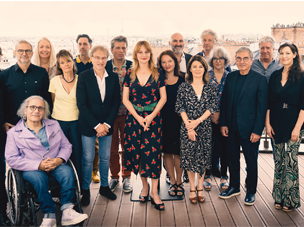To write and to compose are conjugated in the feminine. Many women are learning music. Paradoxically, few women become professionals in the world of musical creation.

Bakel, 29, made her electro-pop debut in 2016. She joined Sacem and joined a publisher, BMG Rights Management France. "In the world of composition, I immediately felt I was in a minority. The image of the woman is associated with the interpreter, and it is a smoke screen," explains the young woman from Roubaix. The facts are there: in 2018, women accounted for only 17% of the 169,400 Sacem members. And the annual rate of female membership is around 21%. "An artist who is starting up is like a fragile raft in a raging sea," says Bakel. Equal opportunities between women and men have not been established. In the studios, it's terrible: I as a woman, of mixed race - I'm surrounded by white men, in their 40s and 50s, who want to help me as soon as I touch a console, as if I didn't have a clue. And above all, we mustn't say anything, because it is contrary to the cool image that the milieu wants to give of itself.”
SOCIAL BUILDING
Women are less numerous, less assisted, less paid, less programmed, less broadcast, less rewarded, less managerial: the report is severe(1), and the symptoms are diverse. According to the report by the High Council for Equality between Women and Men on the inequalities in arts and culture(1), women represented only 6% of the world's scheduled conductors between 2014 and 2017. None of the thirty permanent French orchestras are led by a female chief conductor. Among operas performed in France, only 1% of composers scheduled between 2012 and 2017 were women. However the majority of conservatory students are women: classical orchestras are full of talented female musicians. Where is the gap? When do they fall behind? "The doors of Sacem, which has always guaranteed income equality, are, however, wide open to women songwriters," says Élisabeth Anaïs, an author and a member of Sacem since 1979. She joined the working group on gender equality, set up by the Board of Directors of Sacem last year on the initiative of Christine Lidon, and which also involves Frédéric Doll, Marion Sarraut, and Thierry Perrier. "We wanted men to engage in our discussions. They did so spontaneously and with a lot of conviction. Our goal is to unite women in the music sector. A great momentum has been launched over the last year," explains Christine Lidon, songwriter and member of the Board of Directors. "It's about promoting and encouraging gender equality, and empowering women", says Claire Giraudin, Director of Sacem University.”
First mission: to establish an inventory, then repair the damage "by working to make visible women of any generation, who are free to be themselves: conductor, composer, author, musician, arranger, etc.". In the creative field, women have long held the noble but passive role of muse. "It inspires the creator, at best the performer, but does not create," continues Claire Giraudin. However, talent is, she continues, "a social construction" that serves as a screen for the sidelining of a large part of women.
"A creator needs to be in his bubble. Very often, women release men from all obligation, in order to organise their creative space. The reciprocal is rarely true," says Élisabeth Anaïs, who has benefited from "important male bridges: Claude Lemesle, Yves Simon, and Gabriel Yared ".
As noted by Reine Prat in a 2009 report, commissioned by the Ministry of Culture, "the belief is sustained, even in the twenty-first century, that talent is innate and is the only explanation of the quality of a work, the success of a career path, media recognition [...] We are far from accepting this more trivial reality: the quality of an achievement largely depends, beyond talent alone, on the time that could be devoted to the design and production work, the quantity and the quality of the collaborators that we have been able to bring together [...] all things that have a relation, certainly not exclusive but very precise, with the financial means that the artist can have.”
SHINE A SPOTLIGHT
Ten years after this report, the imbalance is still acute. According to Natacha Krantz, director of the Mercury label at Universal and president of the Victoires de la Musique (French BAFTA), "it is tiring to constantly have to remind women that they are half of a whole. Music induces professions of passion and commitment which presuppose a great confidence in oneself. I was fortunate to have a mother who gave me this gift [Tony Krantz, founder of the Mikado press office, Editor's note] and mentors, male and female, who saved me from doubt about my skills and helped to cope with a family burden which was very complex to organise. When you're a mother and a professional, you need to go to a circus school, with specialty in juggling! Parity happens thanks to male benevolence, women must unite, not divide."
In the Top 200 best sellers in France, there are less than 20% of female artists - even with the incursion of Louane, Angèle, or Aya Nakamura. The ten best-selling albums in France in 2018, according to Snep, have been by men. "Putting female artists in the spotlight is a political decision," says Natacha Krantz.
The music production sector is put into question. While more and more women are working there, "women do not go beyond a glass ceiling that continues to intervene," continues Natacha Krantz. For Anne Cibron, figurehead of French rap who runs the management company Louve (Booba, Orelsan, etc.) and co-manages the labels 92i and 7 Corp, "women face tough and reactionary dictates: the physical, a real bonsai size, the obligation for perfection.
Faced with this, they must free themselves from clichés, build their muscles, build their strength, it is their responsibility. Knowing that the famous glass ceiling does not only concern women, but also all that exceed the model of social assimilation to the French.
In December 2018, the Transmusicales de Rennes, a festival concerned with parity co-directed by Béatrice Macé, one of the few women at the head of a major festival, organised with HF Bretagne a debate aptly titled: "Women raise the sound: they are almost there. Everything is "nearly" there, according to the federation of HF associations, created to identify the inequalities between women and men in the circles of art and culture. "Many networks have been put in place in recent years, says Claire Giraudin. It is important to develop sorority in this extremely competitive environment. " In the catalogue of success stories, the international network shesaid.so stands out. Created in 2014 in Los Angeles by Andreea Magdalina, a music technology specialist, this participatory network wants to "build an environment that supports collaboration, creativity and positive values for all women working in this industry." Led in France by Yaël Chiara, brand manager at PIAS, the network offers information exchanges, professional announcements, concerts, etc.
Created in 2017 for the festival "Les femmes s'en mêlent", the evenings "Rien ne s’oppose à la nuit" (Nothing holds back the night) are experiencing an exponential success. Now called "À définir dans un futur proche" (To define in a close future), they mix actresses, writers, singers, some sometimes trying out the discipline of others, the actress Celine Sallette reading Soeur Emmanuelle before singing Portishead, Camellia Jordana reading excerpts from King Kong Theory, Virginie Despentes, come to support the cause in the House of Poetry Hall, etc. These evenings were designed by casting director Élodie Demey, journalist Géraldine Sarratia, and Melissa Phulpin, head of the artist support and development company Tomboy Lab, which affirms the "clearly feminist" nature of these evenings; we wanted to think about gender and identity.
IMPORTANCE OF NETWORKS
The assertion of the mix of genres has spread, "it helps to be heard," said Melissa Phulpin, who also organises evenings with the film collective "5 050 for 2020". Built on the same principle, the festival The Emancipées is preparing to welcome Claire Chazallisant, Nina Bouraoui, Christine Angot, Blondino, L, Feu! Chatterton, Barbara Carlotti or Virginie Despentes. Decompartmentalisation is a vital factor. "All these initiatives bring out stereotypes; Sacem supports them, because the positive models are essential so that artists like Adele, who is not in the sexist canons of physical appearance, can flourish," concludes Claire Giraudin. "Very quickly, some women artists, such as Clara Luciani, told us that they felt comfortable in our evenings, freed from this accumulation of small remarks that enclose", in the first rank of which we find, according to Melissa Phulpin, comments on the physical. "Prettiness, fragility, it can be tiring". Binetou Sylla, young director at Syllart Records, a historical label for African music in the 18 th arrondissement of Paris, says: "I never answer the misogynist, they are out of place. But they force us to be harder, it's a kind of distortion. For me, the question "Mrs or Miss?" is enough to exasperate me, not to mention invitations to dinner, while negotiating contracts and business models. And, even worse, I heard very recently at a major label where I had an appointment: "Ah, but she is very pretty!" ».
Mistrust is another thorn in the foot, defiance. Béatrice Macé, director of Transmusicales, says she "knew this suspicion of incompetence. And then, the unwelcome questions, of the kind: who has she slept with to get here, who is the man behind her...”.
(1) Report of the High Council for Equality between Women and Men, February 2018.
Published April 12 2019


